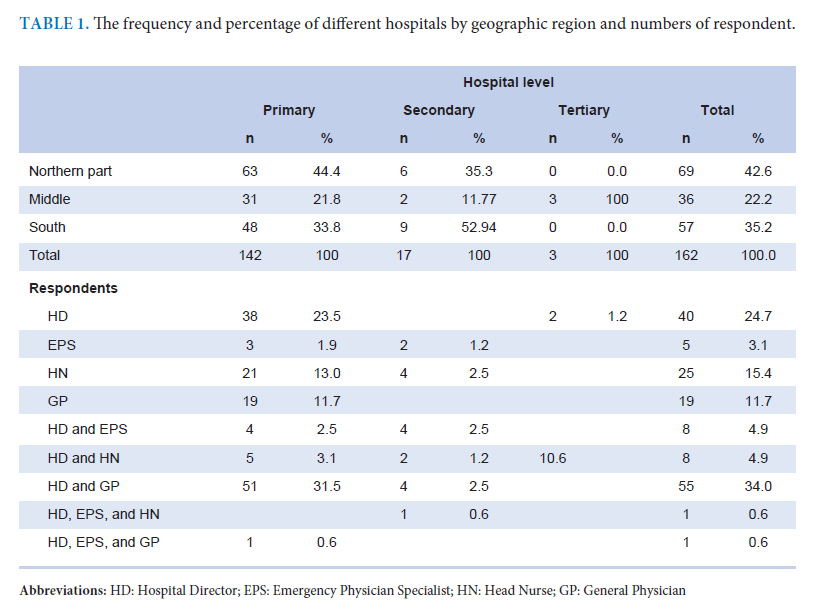A Nationwide Survey and System Analysis of Emergency Triage System in Lao People's Democratic Republic
DOI:
https://doi.org/10.33192/smj.v75i4.260580Keywords:
Health system, Triage system, the Lao People's Democratic RepublicAbstract
Objective: To assess the present status of the emergency department (ED) triage system in 162 hospitals across the Lao People's Democratic Republic (Lao PDR).
Materials and Methods: The Lao PDR nationwide survey participants recruited ED administrators. The EDs were randomly recruited. The standard questionnaire package was used for data collection including patients’ demographics and triage systemic factors. Descriptive analysis was applied to analysis the outcome of interest.
Results: A majority of triage officers were emergency room nurses (58.6%), general physicians (20.4%), or both (11.1%). Most hospitals (89.5%) used informal triage scales such as clinical experiences or colors to prioritize ED patients. Only 17 hospitals (10.5%) had a formal triage scale in their ED care systems and used it in their practice.
Conclusion: These findings provide knowledge of the ED triage system in the Lao PDR. The results indicate that the Lao PDR lacks a formal ED triage scale but uses a variety of informal scales. Thus, it is necessary to set up a standard triage system at all hospitals to standardize ED healthcare across the country.
References
Barma NH, Oksen SR. Lao PDR case study: Ministry of Public Works and Transport; 2014.
Japan International Cooperation Agency. Data collection survey on health sector in lao people’s Emocratic republic. System Science Consultants Inc.; 2016.
Funakoshi H, Shiga T, Homma Y, Nakashima Y, Takahashi J, Kamura H, et al. Validation of the modified Japanese Triage and Acuity Scale-based triage system emphasizing the physiologic variables or mechanism of injuries. International Journal of Emergency Medicine. 2016;9(1):1.
Jordi K, Grossmann F, Gaddis GM, Cignacco E, Denhaerynck K, Schwendimann R, et al. Nurses’ accuracy and self-perceived ability using the Emergency Severity Index triage tool: a cross-sectional study in four Swiss hospitals. Scandinavian Journal of Trauma, Resuscitation and Emergency Medicine. 2015;23(1):62.
Houston C, Sanchez LD, Fischer C, Volz K, Wolfe R. Waiting for triage: Unmeasured time in patient flow. West J Emerg Med. 2015;16(1):39-42.
Aacharya RP, Gastmans C, Denier Y. Emergency department triage: An ethical analysis. BMC Emergency Medicine. 2011;11(1):16.
Park J, Choi H, Kang B, Kim C, Kang H, Lim T. A nationwide survey of Korean emergency department triage systems and scales; A first step towards reform of the emergency medical service system. Journal of the Korean Society of Emergency Medicine. 2014;25(5):499-508.
Ringström C, Andersson B, Bergh C, Börjesson M, Carlström E, Eriksson M, et al. Triage for prioritisation in the emergency department Region Västra Götaland, HTA-centrum; 2018.
Aungsuroch Y, Songnavong C, Tantikosoom P, Phanpaseuth S, Sisoulath A, Gunawan J, et al. Determining nursing research priorities in Lao people's democratic republic: A modified delphi study. Nursing and Midwifery Studies. 2020;9(3):157-62.
Khursheed M, Fayyaz J, Jamil A. Setting up triage services in the emergency department: Experience from a tertiary care institute of Pakistan. A journey toward excellence. J Ayub Med Coll Abbottabad. 2015;27(3):737-40.
Viswanathan K, Hanfling D, Altevogt BM, Gostin LO. Crisis standards of care: A systems framework for catastrophic disaster response: National Academies Press; 2012.
Farrohknia N, Castrén M, Ehrenberg A, Lind L, Oredsson S, Jonsson H, et al. Emergency department triage scales and their components: A systematic review of the scientific evidence. Scandinavian Journal of Trauma, Resuscitation and Emergency Medicine. 2011;19(1):42.
Bill & Melinda Gates Foundation. Lao PDR emergency operations center planning and design mission 2018 [Available from: https://www.gatesfoundation.org/~/media/GFO/Documents/How-We-Work/RFP-Lao-PDR-EOC/Lao-PDR-EOC-Planning-and-Design-Mission-Report.pdf?la=en.
Polit DF, Beck CT. Nursing research: Generating and assessing evidence for nursing practice. 9 ed: China: Lippincott Williams & Wilkins; 2012.
Worldmeter. Laos population (live) 2021 [Available from: https://www.worldometers.info/world-population/laos-population/.
Sa-angchai P, Phienphommalinh S, Yimsamran S, Kaewkungwal J, Kijsanayotin B, Soonthornworasiri N. Geographical distribution of health workforces in Lao PDR. The Southeast Asian Journal of Tropical Medicine and Public Health. 2016;47(4):868-79.
Göransson KE, Ehrenberg A, Ehnfors M. Triage in emergency departments: National survey. Journal of clinical nursing. 2005;14(9):1067-74.
Roodbol PF. Mind the gap: Triage guidelines and their utilisation at the emergency department. Nederlands Tijdschrift voor Evidence Based Practice. 2014;12(2):8-9.
Van Der Wulp I, Van Stel HF. Calculating kappas from adjusted data improved the comparability of the reliability of triage systems: A comparative study. Journal of Clinical Epidemiology. 2010;63(11):1256-63.
Göransson K, Ehrenberg A, Marklund B, Ehnfors M. Accuracy and concordance of nurses in emergency department triage. Scandinavian Journal of Caring Sciences. 2005;19(4):432-8.
Tandi TE, Cho Y, Akam AJ-C, Afoh CO, Ryu SH, Choi MS, et al. Cameroon public health sector: Shortage and inequalities in geographic distribution of health personnel. International Journal for Equity in Health. 2015;14(1):43.

Published
How to Cite
License
Copyright (c) 2023 Siriraj Medical Journal

This work is licensed under a Creative Commons Attribution-NonCommercial-NoDerivatives 4.0 International License.
Authors who publish with this journal agree to the following conditions:
Copyright Transfer
In submitting a manuscript, the authors acknowledge that the work will become the copyrighted property of Siriraj Medical Journal upon publication.
License
Articles are licensed under a Creative Commons Attribution-NonCommercial-NoDerivatives 4.0 International License (CC BY-NC-ND 4.0). This license allows for the sharing of the work for non-commercial purposes with proper attribution to the authors and the journal. However, it does not permit modifications or the creation of derivative works.
Sharing and Access
Authors are encouraged to share their article on their personal or institutional websites and through other non-commercial platforms. Doing so can increase readership and citations.














